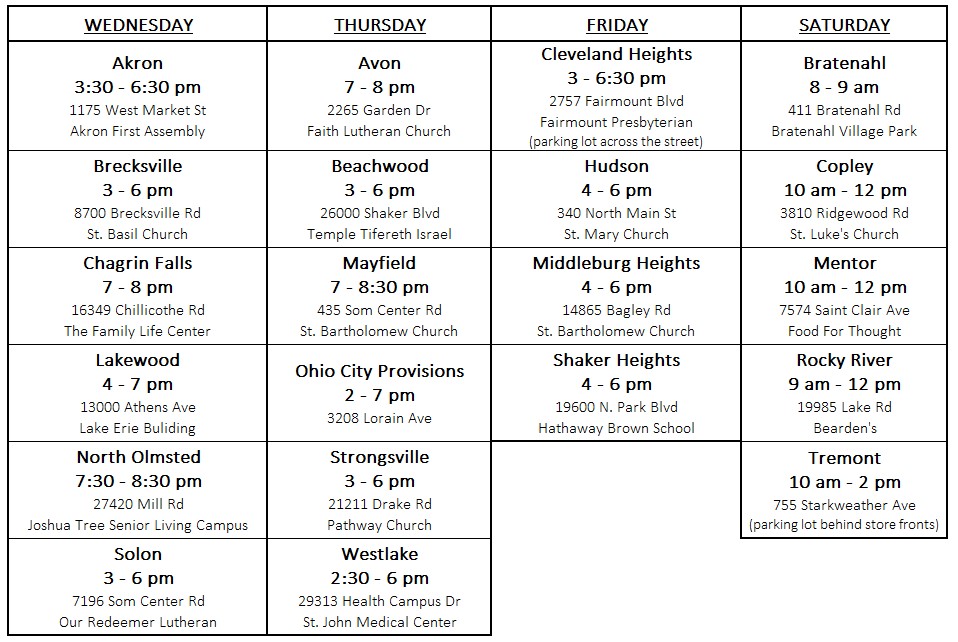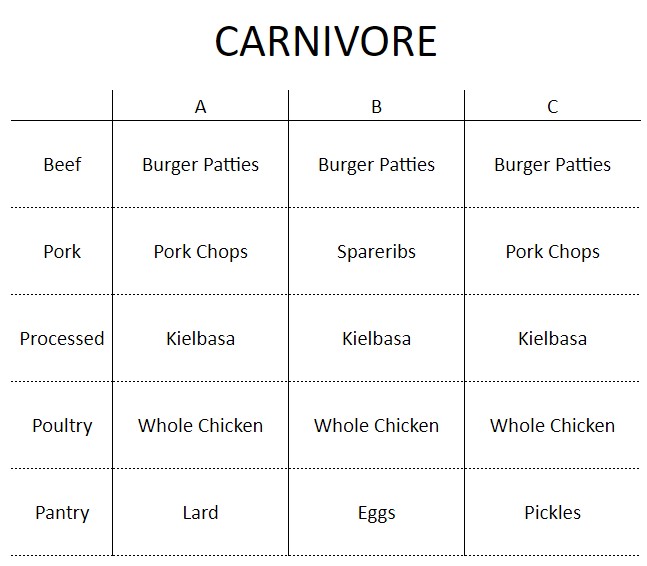Summer 2020 — Week 1 — There’s A Season For Chicken
Week 1 of the Summer Season is here and we are excited! By now you should have already received a confirmation email with your pickup location, bag size and dietary plan, and payment information. If you have emailed or called in lately, we are experiencing a heavy volume of communications and may be a bit slow getting back to you.
In case you missed the confirmation email, here is a link to it: Summer 2020 Processes and Procedures.
Also, please read below for a few administrative clarifications.
Most importantly, below are the bag contents and some information about the farming practices. I, Trevor, haven't directly written each week's newsletter in a few years so I'm excited to be back filling you in on all the details. I tend to be a bit technical sometimes, but I think that's what makes us special. Fresh Fork isn't just groceries. We are farmers and artisans passionate about food. Local food can be bad, and national food can be good. We specialize in finding food made locally with the greatest attention to quality, sustainability, and value for your family. I hope you enjoy this season and embrace each week's bag with as much love as I and the other farmers do in producing your food!
Thank you for joining us this year in our 12th Summer Season. Cheers to a good growing season and lots of healthy smiles in your kitchen and at your dinner table!
Thank you again,
Trevor & the FFM team (Lauren, Allyson, Evan, Connor and all the new Summer 2020 Staff)
50 EXTRA BAGS
In the last decade I've learned that sometimes folks forget to signup. We plan accordingly for the first week and prepare 50 extra shares that are first come, first serve.
If you haven't yet signed up but wish to get in for this week, please register for the Summer Season online TODAY BEFORE MIDNIGHT.
To register: login or create an account at https://csalogin.freshforkmarket.com
Our office staff will go through the orders tomorrow morning and adjust your account to start this week. Please note, this change will adjust the amount due if you select the "upfront" payment. The Small Share is $638, the Large share is $990 and the Mini Share is $682 for the full 22-weeks.
IT'S CHICKEN SEASON

At my farm - Wholesome Valley Farm in Wilmot - I specialize in grass-based livestock production.
What does this mean? It means I focus on growing healthy organic pastures that feed my cattle, hogs, and chickens. Each breed has a different management technique, with the beef on an aggressive pasture rotation, the hogs utilizing the cool shade of the woods, and the chickens "mowing and fertilizing" my pasture.
I like to advertise that there is a season for chickens. Most chicken in the US is raised inside large barns with 0.7 to 1 square foot per chicken. That's fairly tight but some researcher figured out that's the optimum stocking rate to create cheap food. There are plenty of local chickens raised that way. We don't buy those type of birds.
I raise chickens only during the summer growing months and freeze inventory for the winter. I believe that a frozen chicken in the winter that was raised outside with grass and exercise is far superior to a chicken raised in a barn.
Some would say I'm a glutton for punishment. At Wholesome Valley Farm my western pastures look like some form of encampment (photos above). We have 30 drag pens for the chickens - each must be moved daily, feed added and water lines moved along. This takes a few hours each day, 7 days per week.
This structure has no floor and the birds are on grass. Each day we move the drag pens forward to a new piece of grass. This helps to uniformly mow down the pasture and spread the manure evenly. Some growers even call these "chicken tractors" because of how the grass is mowed down behind the pens.
In the end, our birds have a better texture and more flavor than a commercial chicken. Further, the fertilizer they spread in the form of their manure helps to strengthen my pastures which will in turn create more plentiful and healthy grass to feed the beef.
SPECIAL ORDERS
Deadline + Pick-Up Details
As a reminder, you may log into your account online at http://csalogin.freshforkmarket.com/ and place a special order (select "shop for extra items" or "Shop" at the top of the screen) for delivery this week.
ORDER DEADLINE FOR DELIVERY THIS WEEK -- Tuesday at 11:59pm
Lauren has been working hard to update the store inventory. It changes frequently so stop back often. I know this week we didn't get a chance to inventory the beef cuts that came in so those will most likely be available next week.
Your special order will be delivered only to your primary location as selected in your profile (see below). Please review this BEFORE placing your order (adjust + save as needed). Please do not email or call to change the location of your special order. It sounds easier said than done. Our software prints a pick list per location for what products we must take along. If we attempt to move it manually there is a high probability that we'll mess it up and no one will be happy.
When you get to you check-in, please let the greeter know you also have a special order to pick-up. The order is packed separate from the regular share.

PICK-UP LOCATION DETAILS

CHICKEN 101 BASICS

I learned years ago from my friend Chef Parker Bosley that a whole chicken is the best value in food. It can be prepared whole for an easy family meal or broken into parts (breast, thigh, drums, wings, and bones) for several different dishes.
If you are new to working with a whole chicken, we suggest simply roasting the chicken and saving any bones/scraps to make chicken stock (recipe below).
Here I'll answer two common questions about whole chicken:
Should I brine the chicken? Brining is the technique of seasoning a piece of meat inside and out by either submerging it in a bath (liquid brine) or rubbing it with seasonings (dry brine or a "cure" or a rub, depending on how hip and fancy you want to sound).
The brine does two important things: 1) It exchanges water in the meat for seasoned water from the brine, and 2) I think of it as an insurance plan on meat. The added and retained moisture helps prevent you from drying out the meat.
Summary: I recommend brining. It is, however, not necessary.
Brining is super easy. The basic ratios you need to understand:
Kosher or Sea Salt: 3%
Sugar (optional): 2%
Black Pepper: 0.5%
Spices: 0.5%
These percentages are percentages by weight of the "green weight." That means that if your bird weighs 5 lbs, you need 3% of that in salt. I do everything in metric. So 5 lbs x 454 grams per lbs equals 2,270 grams. 3% is 68 grams of salt. Most kitchen scales easily switch between standard and metric measurements. It is important to use weights as not all salts and spices weight the same per cup. A course ground salt will have a different density than a fluffy course crystal salt.
How to brine: Get your salt, sugar, and spices ready by weight. Figure out your brining vessel. It can be a non-reactive stainless pot, a dutch oven, a glass bowl, even a vacuum bag or plastic bucket. All that matters is that you have enough water to submerge the bird by an inch. The water is a medium for carrying the spices to the bird.
Step 1: So the easy technique is to pick your brining vessel first. Grab a mason jar and start pouring one pint of water at a time over the chicken until it is fully submerged. Count your pints and now you know how much water you need. Pour out the water.
Step 2: In a stock pot, add the amount of water you measured for the brine. Bring to a simmer and stir in the salt and spices. Refrigerate and chill the brine to below 40 degrees . Pour the cold brine over the chicken in the brining vessel and place the chicken in the refrigerator.
The brine penetrates at about 1 inch per day from both the inside and outside of the chicken's cavity, so 24 hours of refrigerated brining is sufficient.
Photos below: Left, breaking a raw chicken into parts. Right, Adam and I demonstrating brining a turkey at OCP.
CHICKEN STOCK
I think my cooking changed big time when I learned the importance of rich stock in the kitchen. It is both flavorful and nutritious.
Chef Parker Bosley first taught me about stock. He is very particular about it and can wax on poetically about the nuances he has picked up over the years.
More bones:
At the online store, we have chicken backs on sale. You can buy a 5# bag of these to supplement the bones from your chicken carcass left after you eat this week's chicken. 5# bag for just $9. Order online at https://csalogin.freshforkmarket.com
I'll try to make it very simple.
Step 1: Don't even put your chicken backs or bones in the freezer. Put them in a stockpot right away. If you aren't going to make stock tonight, put them in the stockpot in the fridge to thaw so you don't forget about them.
Repeat. The freezer is where food goes to die slowly. Just start cooking it now.
Step 2: Add to the stockpot (optional) a few branches of celery (or frozen celery leaves from the summer), a few peeled carrots, an onion, a few cloves of garlic, and (if you have it) a few sprigs of fresh thyme or about a teaspoon of dried thyme.
Step 3: Fill the stockpot with cold water until the bones are submerged by about an inch or more.
Step 4: Bring the water to a simmer - just barely a boil - and let it simmer for at least 4 hours. I often find the perfect setting and let it roll overnight (be careful not to evaporate the water and scorch your pan).
Step 5: Strain out the bones and solids while the stock is hot. Pass it first through a colander to remove the large pieces, then a second time through a fine sieve (like a chinois) or a damp kitchen towel. Refrigerate overnight.
Step 6: The fat will solidify on the top after it is cold. Remove the fat. If the stock is not "rich" enough for you, simply reduce it down at a boil. Some like a lighter stock that is more of a broth, while other applications call for a rich stock that is thick in gelatin.
That's all there is to it. If you don't want to do it on the stovetop, you can also do the same thing in a crock pot. The fastest way to make stock is with a pressure cooker or Instapot - same process, just less time.
I made the stock, now what do I do with it?
You've probably heard all the buzz around bone broth, right? Same thing. Drink it for it's health benefits. If you do drink it, don't forget to season it some with salt and pepper.
Stock is also an important component of cooking. Use it to braise a pork roast or as the base for a soup. It also can be used to make gravy or to add flavor to a ragout of asparagus and ramps or even a risotto. The applications of stock are endless. It has become one of the "staples" in my refrigerator that is in my toolbox for any meal that might arise.
Depending on the amount of stock you make, you may have "extras" to use at a later date. We recommend freezing in easy to use volumes -- like a quart. We keep our empty yogurt quart containers and recycle them for saving stock in the freezer.
BAG CONTENTS


Reminder: Carnivore Share bags are every-other-week based on pick-up location. You will be randomly assigned to a group (A, B, C). By the end of the season, all groups will have received the same amount of all products.
Week 1 Locations (odd numbered weeks):
Akron, Beachwood, Bratenahl, Chagrin Falls, Cleveland Heights, Copley, Hudson, Mayfield, Mentor, Shaker Heights, Solon
We've created a page the website for easy reference of the Week # plus date, and a list of locations assigned to each week.
**Carnivore share bags are only available at the first "dropoff location" listed on the location tab of your account as of 6/1. We pack for the exact number based on location.**
